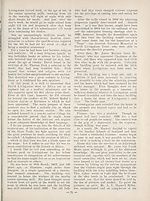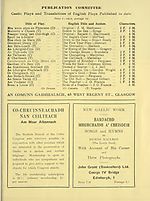An Comunn Gàidhealach Publications > Gaidheal > Volumes 58--62(part), January, 1963--March 1967
(102) Page 72
Download files
Complete book:
Individual page:
Thumbnail gallery: Grid view | List view

paid for by the many organisations who came
forward offering to make contributions to the
work of restoration. Models were made by
Mr. C. d’O. Pilkington Jackson, the sculptor,
and again paid for by organisations who volun¬
teered to help.
Yet another idea came from Sir Frank Mears
and Mr. Pilkington Jackson. They devised a
plan to join four of the rooms together to form
a long low gallery and, by using the old bed
recesses to house the models, made the now
famous ‘ ‘ Livingstone Gallery. ’ ’ This room,
in semi-darkness, contains eight pieces of
tableaux, each illuminated by the visitor
operating a switch, telling of Livingstone’s
life work in Africa. Each was financed by
various societies with which the missionary
was connected.
Perhaps the most impressive of the models
made by Mr. Pilkington Jackson is his wood
carving “The Last Journey’’ showing a group
of African natives carrying Livingstone’s
embalmed body to the coast. This is the gift
of the Bamangwato Tribe with whom Living¬
stone was closely associated.
The birthroom itself has been restored to
look as it would in Livingstone’s boyhood.
Many pieces of furniture are original, among
them the wag-at-the-wa’ clock which must
have lulled the young David to sleep. Other
relics in the room have been gifted by Blantyre
people many of whom had close links with the
old building in its Shuttle Row days.
The story which is unfolded to the Visitor
comes to an appropriate end in The Shrine.
Here a brass plate on the floor bears the in¬
scription as it appears on Livingstone’s grave
in Westminster Abbey and behind it, on the
wall, is a cross made from the Wood of the
Mvula tree at Chitambos Village where Living¬
stone’s heart is buried. Surly a Wonderful
tribute to Ligingstone by Africans that his
heart was, and is, in Africa.
Having completed plans for the building,
attention was turned to the adjoining ground
and here it was decided to use the space for
playing fields for children who might come to
visit Livingstone’s birthplace. Such had been
the response of children that additional ground
has recently had to be obtained. On many a
Saturday afternoon during the summer, upwards
of two thousand children can be seen playing in
the grounds.
In the grounds there is also a unique fountain
gifted by a former governor of the Trust. This
fountain is called ‘ ‘ The World Fountain ’ ’
and is in the shape of the globe. It is so
designed, with the British Isles at the top, to
form a sun dial, showing by where the sun strikes
it, those parts of the world which are at the
first set of paintings telling of Livingstone’s
— 72
youth, the committee was so impressed that a
further series dealing with his ancestry Was
commissioned. These and the many other
paintings which the artist has done since, were
same time illuminated by the sun. The globe,
itself about six feet in diameter, is surrounded
by a double basin. The inner basin is
surrounded by five plaques which portray the
elementary occupations of mankind whilst in
the outer and lower basin pre-historic creatures
in bronze throw fine sprays of water over the
whole. On a bright day the effect is very
beautiful.
There are, too, rain-shelters made in the
shape of African huts and also a model of the
hut in which Livingstone died. Set apart from
the playing fields there are rose gardens where
the older folks can retire for a time away from
the bustle of playing children, to enjoy in a
quiet picturesque setting some of the wonders
of nature.
Since the Memorial Was opened on 29th
October, 1929 by The Duchess of York, later
Queen Elizabeth and now The Queen Mother
(who last year graciously consented to becojne
Patron), almost two million visitors have
passed through the turnstiles. They come from
all over the world and from all Walks of life
to see the tribute to a great Scot in the
Memorial to David Livingstone.
Inverness Branch
The Inverness Branch all-Gaelic Drama
Group under the leadership of Mr. Alexander
Fraser, Headmaster of Hilton School, during
March, April, and May played at Inverness,
Invershiel, and Torridon. The plays were
A’ Chailleach, Ruairidh Roimh-ainmichte, and
two sketches, Doimhgean agus Ruairidh, and
Dr. B. Ching aig an Aiseag. They were well
received, particularly in Kintail and Torridon
where there were very good houses. The group
is much indebted to Mr. Hamilton of the
DOAS, Inverness, who coached them.
Letter to Editor
56 Douglas Street,
Motherwell,
Lanarkshire,
2/5/63.
Fhir Dheasachaidh,
Bu mhath learn fios a chur thugaibh ag radh
gun do chuir mi feum air na leasain sin a bha
aig Mgr. Iain A. MacDhomhnaill anns “A’
Ghaidheal.’’ Bha clasaichean feasgair agam
agus gu dearbh bidh mi toilichte ma thoisicheas
iad a rithist ann am mios na Sultuine.
Leis gach deagh dhurachd,
Norman E. Macponald .
forward offering to make contributions to the
work of restoration. Models were made by
Mr. C. d’O. Pilkington Jackson, the sculptor,
and again paid for by organisations who volun¬
teered to help.
Yet another idea came from Sir Frank Mears
and Mr. Pilkington Jackson. They devised a
plan to join four of the rooms together to form
a long low gallery and, by using the old bed
recesses to house the models, made the now
famous ‘ ‘ Livingstone Gallery. ’ ’ This room,
in semi-darkness, contains eight pieces of
tableaux, each illuminated by the visitor
operating a switch, telling of Livingstone’s
life work in Africa. Each was financed by
various societies with which the missionary
was connected.
Perhaps the most impressive of the models
made by Mr. Pilkington Jackson is his wood
carving “The Last Journey’’ showing a group
of African natives carrying Livingstone’s
embalmed body to the coast. This is the gift
of the Bamangwato Tribe with whom Living¬
stone was closely associated.
The birthroom itself has been restored to
look as it would in Livingstone’s boyhood.
Many pieces of furniture are original, among
them the wag-at-the-wa’ clock which must
have lulled the young David to sleep. Other
relics in the room have been gifted by Blantyre
people many of whom had close links with the
old building in its Shuttle Row days.
The story which is unfolded to the Visitor
comes to an appropriate end in The Shrine.
Here a brass plate on the floor bears the in¬
scription as it appears on Livingstone’s grave
in Westminster Abbey and behind it, on the
wall, is a cross made from the Wood of the
Mvula tree at Chitambos Village where Living¬
stone’s heart is buried. Surly a Wonderful
tribute to Ligingstone by Africans that his
heart was, and is, in Africa.
Having completed plans for the building,
attention was turned to the adjoining ground
and here it was decided to use the space for
playing fields for children who might come to
visit Livingstone’s birthplace. Such had been
the response of children that additional ground
has recently had to be obtained. On many a
Saturday afternoon during the summer, upwards
of two thousand children can be seen playing in
the grounds.
In the grounds there is also a unique fountain
gifted by a former governor of the Trust. This
fountain is called ‘ ‘ The World Fountain ’ ’
and is in the shape of the globe. It is so
designed, with the British Isles at the top, to
form a sun dial, showing by where the sun strikes
it, those parts of the world which are at the
first set of paintings telling of Livingstone’s
— 72
youth, the committee was so impressed that a
further series dealing with his ancestry Was
commissioned. These and the many other
paintings which the artist has done since, were
same time illuminated by the sun. The globe,
itself about six feet in diameter, is surrounded
by a double basin. The inner basin is
surrounded by five plaques which portray the
elementary occupations of mankind whilst in
the outer and lower basin pre-historic creatures
in bronze throw fine sprays of water over the
whole. On a bright day the effect is very
beautiful.
There are, too, rain-shelters made in the
shape of African huts and also a model of the
hut in which Livingstone died. Set apart from
the playing fields there are rose gardens where
the older folks can retire for a time away from
the bustle of playing children, to enjoy in a
quiet picturesque setting some of the wonders
of nature.
Since the Memorial Was opened on 29th
October, 1929 by The Duchess of York, later
Queen Elizabeth and now The Queen Mother
(who last year graciously consented to becojne
Patron), almost two million visitors have
passed through the turnstiles. They come from
all over the world and from all Walks of life
to see the tribute to a great Scot in the
Memorial to David Livingstone.
Inverness Branch
The Inverness Branch all-Gaelic Drama
Group under the leadership of Mr. Alexander
Fraser, Headmaster of Hilton School, during
March, April, and May played at Inverness,
Invershiel, and Torridon. The plays were
A’ Chailleach, Ruairidh Roimh-ainmichte, and
two sketches, Doimhgean agus Ruairidh, and
Dr. B. Ching aig an Aiseag. They were well
received, particularly in Kintail and Torridon
where there were very good houses. The group
is much indebted to Mr. Hamilton of the
DOAS, Inverness, who coached them.
Letter to Editor
56 Douglas Street,
Motherwell,
Lanarkshire,
2/5/63.
Fhir Dheasachaidh,
Bu mhath learn fios a chur thugaibh ag radh
gun do chuir mi feum air na leasain sin a bha
aig Mgr. Iain A. MacDhomhnaill anns “A’
Ghaidheal.’’ Bha clasaichean feasgair agam
agus gu dearbh bidh mi toilichte ma thoisicheas
iad a rithist ann am mios na Sultuine.
Leis gach deagh dhurachd,
Norman E. Macponald .
Set display mode to:
![]() Universal Viewer |
Universal Viewer | ![]() Mirador |
Large image | Transcription
Mirador |
Large image | Transcription
| An Comunn Gàidhealach > An Comunn Gàidhealach Publications > Gaidheal > Volumes 58--62(part), January, 1963--March 1967 > (102) Page 72 |
|---|
| Permanent URL | https://digital.nls.uk/127150005 |
|---|
| Description | This contains items published by An Comunn, which are not specifically Mòd-related. It includes journals, annual reports and corporate documents, policy statements, educational resources and published plays and literature. It is arranged alphabetically by title. |
|---|
| Description | A collection of over 400 items published by An Comunn Gàidhealach, the organisation which promotes Gaelic language and culture and organises the Royal National Mòd. Dating from 1891 up to the present day, the collection includes journals and newspapers, annual reports, educational materials, national Mòd programmes, published Mòd literature and music. |
|---|---|
| Additional NLS resources: |
|

